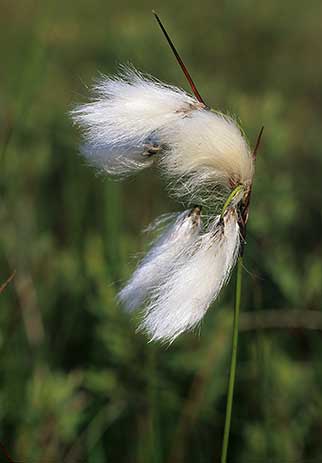Cottongrass (Eriophorum angustifolium)
When: May - June
How many: Relatively widespread and often abundant

In and around the wetter areas of the New Forest, particularly in the valley mires, fluffy white cottongrass flower-heads are at their most conspicuous in late-spring. Rarely still, forever rippling in the breeze, they add a welcome contrast to the surrounding expanses of green and straw-coloured vegetation.
An unmistakable plant when in flower, common cottongrass grows to a height of around 60 centimetres (24 inches), and has relatively long-stalked clusters of nodding flower-heads that gave rise to the alternative name, multi-headed bog cotton.
There is, though, potential for confusion with three other similar cottongrass species that also occur in the New Forest: the extremely rare slender cottongrass, the slightly less rare broad-leaved cottongrass, and the locally distributed hare’s-tail cottongrass.
Look out for extremely narrow leaves in slender cottongrass; relatively wide leaves in broad-leaved cottongrass, and in hare’s-tail cottongrass, densely tufted, tussock-forming stems, and flowers on single, upright spikes.
Sometimes also known as ghost grass, cottongrass plants are not really grasses at all for they are more closely related to the sedge family, and the ‘hairs’ are actually modified petals and sepals that provide wind-assisted, long distance dispersal of the attached seeds.
Nowadays cottongrass simply has scenic value and serves to warn the unwary of wet places ahead, but not so long ago these unkempt heads of silvery hair, fleecy banners waving in the breeze, as they were once admirably described, were used for stuffing pillows and mattresses, for making candle wicks and, along with sphagnum moss, for First World War wound-dressings.
References:
The Flora of Hampshire: Anne Brewis, Paul Bowman and Francis Rose
Collins New Generation Guide - Wild Flowers of Britain and Northern Europe: Alastair Fitter
Reader’s Digest Field Guide to the Wild Flowers of Britain
More links
Other related links
Search this site

Sadly, 58 animals were killed - 35 ponies, 13 cows, 8 donkeys and 2 sheep, whilst a further 32 were injured - 3 pigs, 9 donkeys, 11 cows and 9 ponies.
(Forty-three accidents occurred in daylight, 15 at twilight and 101 in the dark. Twenty-seven accidents were not reported by the driver involved).
Here's just one horrific example - Three donkeys killed in collision with van at notorious New Forest blackspot (Advertiser and Times)

